Baron Lisle
Baron Lisle was a title which was created five times in the Peerage of England during the Middle Ages and Tudor period. The earliest creation was in 1299 for John de L'Isle of Wootton on the Isle of Wight, then in the County of Southampton,[2] now in Hampshire. The family's name in French was de l'Isle and was Latinised to de Insula (both meaning "from the island"). They were also known by the Latinised cognomen de Bosco[3] (literally "from the woodland", from the Germanic word bosk, in French bois[4]) referring to their "well-wooded" seat at Woodeton/Wodingtone (today Wootton).[5] The family is assumed to have arrived in the Isle of Wight as a feudal follower of the Norman magnate Richard de Redvers (d.1107),[6] Lord of the Isle of Wight and feudal baron of Plympton in Devon,[7] and father of Baldwin de Redvers, 1st Earl of Devon. Below the de Redvers family that of de Lisle was the most important on the Island.[8] John de Lisle, 2nd Baron Lisle (c.1281-1331) married Roesia de Cormeilles, daughter and heiress of Sir John de Cormeilles of Thruxton in Hampshire, which thenceforth became the de Lisle's principal seat.[9] Bartholomew de Lisle, 3rd Baron Lisle (1308-1345) married Elizabeth de Courtenay, a daughter of Hugh de Courtenay, 1st/9th Earl of Devon (1276–1340),[10][11] successor to de Redvers, although no longer Lord of the Isle of Wight, which was sold in 1293 to King Edward I by Isabel de Forz, daughter and heiress of the last de Redvers Earl. The arms of Lisle of Wootton were: Or, on a chief azure three lions rampant of the first,[12] as is visible on the monumental brass in Thruxton Church of John de Lisle, 5th Baron Lisle (1366-1408),[13] which also shows the arms of de Lisle impaling Courtenay, possibly for an unknown second wife of the 5th Baron, or possibly as a commemoration of the marriage of the 3rd Baron.[14] The 5th Baron (de jure[15]) served twice as a Member of Parliament for Hampshire in 1401 and 1404.[16] The last in the male line was John Lisle, 9th Baron Lisle (d. circa 1523),[17] whose chest tomb and recumbent effigy survives in Thruxton Church in Hampshire.[18]
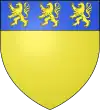
_ThruxtonChurch_Hampshire.xcf.png.webp)
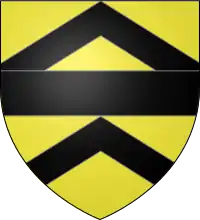

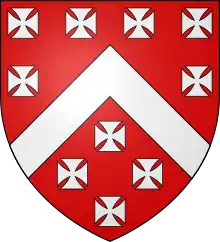
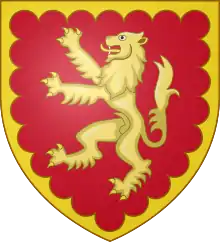
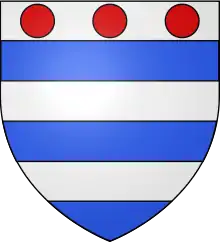
The barony of 1311 was created for De Lisle "of Rougemont", another unrelated family, thought to have originated on the Isle of Ely in Cambridgeshire, East Anglia, where they were feudal tenants of the Bishop of Ely,[19] They were seated at Rougemont Castle in the parish of Weeton, North Yorkshire and bore arms: Or, a fess between two chevrons sable.
The barony of 1357 was for Lisle "of Kingston Lisle" in the parish of Sparsholt in Berkshire (now in Oxfordshire), a junior branch of Lisle of Rougemont. Robert de Lisle of Rougemont married Alice FitzGerold (granddaughter of Henry FitzGerold I (d.1173/4)), the heiress of Kingston, Sparsholt. In 1269 Alice granted the manor of Kingston to her younger son Gerard I de Lisle, whose family adopted the arms of FitzGerold: Gules, a lion statant guardant argent crowned or. Gerard I's grandson was Gerard II de Lisle (1305–1360), created Baron Lisle in 1357.[20]
The most recent creation came in the Peerage of Ireland in 1758, when John Lysaght was made Baron Lisle, of Mountnorth in the County of Cork. He had previously represented Charleville in the Irish House of Commons. As of 2013 the title is held by his descendant, the ninth Baron, who succeeded his father in 2003. The barony is pronounced "Lyle", the family surname of Lysaght "Lycett".
Barons Lisle, First Creation (1299)
- John Lisle, 1st Baron Lisle (died 1304)
- John Lisle, 2nd Baron Lisle (1281–1337)
Barons Lisle (of Rougemont), Second Creation (1311)
- Robert Lisle, 1st Baron Lisle of Rougemont (1288–1344)
- John Lisle, 2nd Baron Lisle of Rougemont (c. 1318–1355)
- Robert Lisle, 3rd Baron Lisle of Rougemont (1334–1399)
"If [he had no legitimate heirs] any right to the Barony would be vested in the heirs of the body of his ... sister, Elisabeth (who d. about 1377), by her husband, William, Lord Aldeburgh."
Barons Lisle (of Kingston Lisle), Third Creation (1357)
- Gerard Lisle, 1st Baron Lisle (1305–1360)
- Warin Lisle, 2nd Baron Lisle (1333–1382), son
- Margaret Lisle, 3rd Baroness Lisle (1360–1392), daughter
- Elizabeth Berkeley, 4th Baroness Lisle (c.1386–1422) (abeyant 1422), daughter
Barons Lisle, Fourth Creation (1444)
- John Talbot, 1st Viscount Lisle (1426–1453) (created Viscount Lisle 1451), grandson
- Thomas Talbot, 2nd Viscount Lisle (1443–1470), son; (viscountcy extinct, barony abeyant 1470)
- Elizabeth Talbot, 3rd Baroness Lisle (died 1487), sister; (abeyance terminated 1475)
- Edward Grey, 1st Viscount Lisle (died 1492), husband
- John Grey, 4th Baron Lisle (1481–1504), son
- Elizabeth Grey, 5th Baroness Lisle (1505–1519), daughter
- Elizabeth Grey, 6th Baroness Lisle (c. 1483-c. 1525), aunt
Attainder of heirs from 1st marriage of the 6th Baroness Lisle and abeyance of heirs from her 2nd marriage.
Barons Lisle, Fifth Creation (1561)
- Ambrose Dudley, 1st Baron Lisle and 3rd Earl of Warwick (1528–1590) (extinct)
Barons Lisle, Sixth Creation (1758)
John Lysaght was created the first Baron Lisle of Mountnorth in the County of Cork in the Peerage of Ireland on 18 September 1758.
Crest: A dexter arm embowed in armour, the hand holding a sword, all ppr.
Supporters: Two lions or.
Motto: Bella! horrida bella!
- John Lysaght, 1st Baron Lisle (1702–1781)
- John Lysaght, 2nd Baron Lisle (1729–1798)
- John Lysaght, 3rd Baron Lisle (1781–1834)
- George Lysaght, 4th Baron Lisle (1783–1868)
- John Arthur Lysaght, 5th Baron Lisle (1811–1898)
- George William James Lysaght, 6th Baron Lisle (1840–1919)
- John Nicholas Horace Lysaght, 7th Baron Lisle (1903–1997)
- Patrick James Lysaght, 8th Baron Lisle (1931–2003)
- Nicholas Geoffrey Lysaght, 9th Baron Lisle (born 1960)
The heir presumptive is the present holder's brother Hon. David James Lysaght (born 1963).
The heir presumptive's heir apparent is his son George Gabriel Abbott Lysaght (born 1997).
Further reading
References
- Debrett's Peerage, 1968, p.1015, E. of Shrewsbury & Waterford
- G. E. Cokayne, The Complete Peerage, n.s., Vol.VIII, p.39
- Whitehead, p.115
- Larousse, Dictionnaire de la langue francaise, "Lexis", Paris, 1979, p.203
- Whitehead, p.115
- Whitehead, p.112
- Sanders, I.J., English Baronies, Oxford, 1960, p.137, Plympton
- Whitehead, p.111
- Whitehead, pp.116,130; However, VCH states: "Precisely when the Cormeilles family parted with the manor (of Thruxton) and how the Lisles acquired it has not been discovered, but Sir John de Lisle, who died in 1407, desired to be buried in the church" ('Parishes: Thruxton', in A History of the County of Hampshire: Volume 4, ed. William Page (London, 1911), pp. 387-391)
- G. E. Cokayne, The Complete Peerage, n.s., Vol.VIII, pp.41-2
- Vivian, Lt.Col. J.L., (Ed.) The Visitations of the County of Devon: Comprising the Heralds' Visitations of 1531, 1564 & 1620, Exeter, 1895, p.244
- Burke's General Armory, 1884, p.611
- G. E. Cokayne, The Complete Peerage, n.s., Vol.VIII, pp.43-4; see imageFile:MonumentalBrass JohnDeLisle 5thBaronLisle (1366-1408) ThruxtonChurch Hampshire.xcf
- G. E. Cokayne, The Complete Peerage, n.s., Vol.VIII, pp.43-4, note r
- G. E. Cokayne, The Complete Peerage, n.s., Vol.VIII, p.43
- History of Parliament biography
- G. E. Cokayne, The Complete Peerage, n.s., Vol.VIII, p.46
- see imageFile:Effigy JohnLisle 9thBaronLisle DiedCirca1523 ThruxtonChurch Hampshire.jpg
- G. E. Cokayne, The Complete Peerage, n.s., Vol.VIII, p.69, note d
- Victoria County History, Berkshire: Volume 4, 1924, pp 311–319, Parishes: Sparsholt (Kingston Lisle) . Arms of Lisle of Kingston Lisle Gules, a lion statant guardant argent crowned or, per Byrne, Muriel St Clare, (ed.), The Lisle Letters, London & Chicago, 1981, p.178
- Secondary Sources
- Kidd, Charles, Williamson, David (editors). Debrett's Peerage and Baronetage london and New York: St Martin's Press, 1990.
- Charles Mosley (ed.), Burke's Peerage and Baronetage (106th edition, 1999), vol.1, p. 1732
- http://www.leightrayment.com%5B%5D

